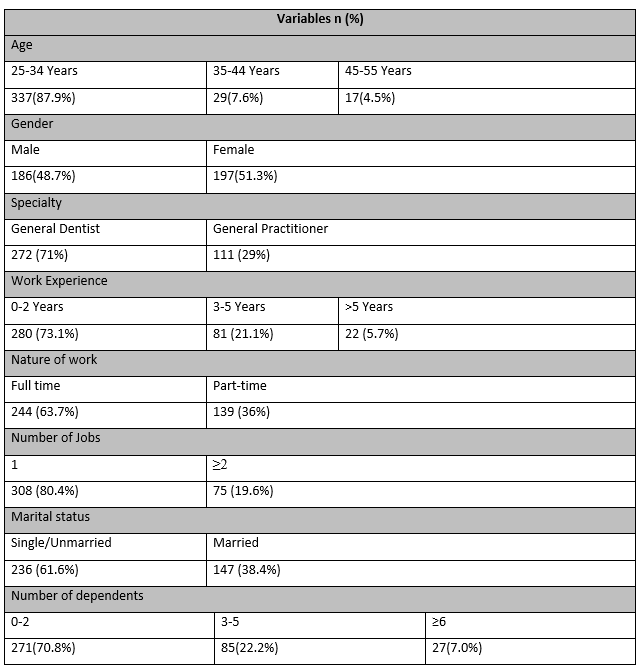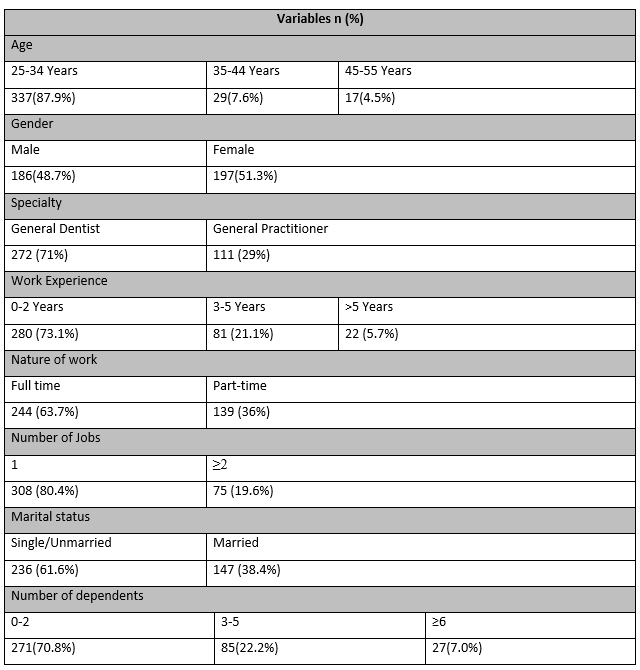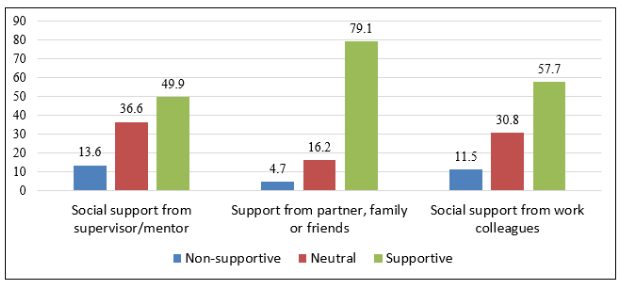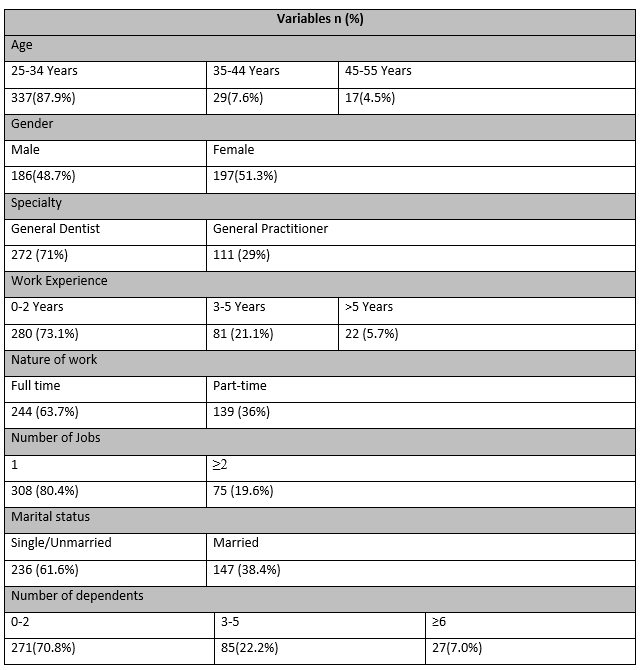By Asma Dahar1, Sudesh Luhana2
- Hospital & Healthcare Management Department, Institute of Health & Business Management, Jinnah Sindh Medical University, Karachi, Pakistan
- Operative Dentistry Department, Sindh Institute of Oral Health Sciences, Jinnah Sindh Medical University, Karachi, Pakistan
DOI: https://doi.org/10.36283/PJMD13-1/016
How to cite: Dahar A, Luhana S. Analyzing Professional Well-being: The Intersection of Demographics, Work-Life Balance and Job Satisfaction. Pak J Med Dent. 2024;13(1): 88-95. Doi: 10.36283/PJMD13-1/016
Background: Work-life balance (WLB) is a multifaceted and contemporary phenomenon where individuals strive to attain balance among their personal, professional, and social domains. Unfortunately, it hasn’t received significant consideration. This study aimed to investigate and comprehend the impact of demographics on WLB and work satisfaction amongst medical and dental professionals.
Methods: An observational, cross-sectional study was performed between medical and dental professionals in Karachi from January to March 2023. The questionnaire consisted of demographics, work details, work satisfaction-related questions, and psychological and support questions, which were evaluated using a 3-point Likert scale. Analysis was done using SPSS software version 26 with p<0.05. The chi-square test and Pearson correlation test were employed to observe the association pattern.
Results: A total of 383 out of 385 responses (99.4%) were included in the study. Females constituted 51.3% and males made up 48.7% of the sample. Of those, who belonged to the dental department 71% and 29% belonged to the medical department. In this sample, variables such as marital status (p=0.044), department (p<0.001), and dependents (p=0.010) were found to be significant with WLB score. In contrast, gender (p=0.032), marital status (p=0.022), and dependents (p<0.001) were significant with work satisfaction scores.
Conclusion: A notable correlation was observed between demographics and work-life balance score (WLB). Institutions are encouraged to prioritize initiatives that increase awareness among their staff and nurture a stress-free environment to enhance well-being, contributing to individual satisfaction and organizational growth.
Keywords: Burnout, Job satisfaction, Stress, Social support, Work-life balance.
The endeavor for a prosperous medical career has consistently been associated with steadfast dedication and relentless commitment, as healthcare professions have always been strenuous at all times. Maintaining a good work-life balance remains a challenge for individuals practicing these professions. In terms of the impact on a professional’s life, insufficient incentives along with poor management systems can lead to harsh consequences on the well-being of medical and dental professionals. These implications range from poor marital life and overall health to even shorter life expectancy. This has resulted in an increment in burnout and work-life dissatisfaction1.
The demanding nature of the medical profession places doctors in a unique position where the boundary between work and personal life often blurs. Work-life balance is characterized as an individual’s interpretation of harmony between various life roles. This dynamic notion impacts how individuals perceive the compatibility of work and non-work activities, conforming it with their current life priorities to foster personal growth whereby work-life imbalance is frequently associated with burnout2,3.
A systematic review by Reinhart indicates that the prevalence of burnout and dissatisfaction is more frequent among young physicians than among older and experienced ones4. Literature by Gold interprets that female healthcare professionals face some extra challenges during work which may lead to burnout. These obstacles include harassment and mistreatment, not only by the staff and colleagues but also by patients which eventually leads to a reduction in job satisfaction. He also mentions that other factors such as managing the home and responsibilities of children may also contribute to work-life imbalance5.
Over the last 50 years, there has been a notable rise in the number of women studying, qualifying, and practicing healthcare professions traditionally dominated by men, such as medicine and dentistry. It is crucial to explore how the complex nature of these professions intersects with their personal lives, potentially impacting their overall well-being and professional satisfaction6.
A study conducted on work-life balance among female doctors in Bangladesh revealed that the respondents encountered difficulties in achieving a satisfactory balance between their professional and personal lives due to cultural and familial expectations, extended working hours, overtime demands, mental health concerns, work-related stress, limited career prospects, average compensation, and workplace insecurity7.
Studies conducted on the topic of suicide rate among doctors have found that suicide and other psychiatric disorders are more prevalent among doctors than in the general population. This is attributed to an increase in emotional and physical distress experienced by these professionals. As per the literature, long working hours, poor work-life balance, family stress and politics of organization are compounding factors in this situation8,9.
A study conducted in Pakistan revealed a positive association between suicidal ideation and work-family conflict among physicians. Conversely, perceived life satisfaction was determined as a factor that could alleviate both work-family conflict and suicidal ideation10. Estimates indicate that decreased clinical hours and physician turnover due to burnout, costs around 4.6 billion USD annually in the US11. Several studies propose that burnout in physicians is an occupational hazard and it requires a systematic approach to manage it12,13. It was also noted that they experienced a rise in burnout levels and depression. According to the literature, research on work-life balance has expanded over the years. However, this expansion has also revealed a research gap related to issues concerning work and family that still lacks significant attention from researchers14.
The rationale of this study lies in addressing associations between various demographic factors (gender, marital status, department, number of dependents, and age) and WLB, work satisfaction along providing foundational support for awareness programs. By recognizing the correlation between these factors and professional well-being, the study advocates for proactive measures within institutions. Strategies that people can employ to preserve WLB include flexible working time, setting boundaries, prioritization of tasks, taking frequent breaks, effective communication, and employers conducting wellness programs. This study aimed to investigate and comprehend the impact of demographics on WLB and work satisfaction amongst medical and dental professionals.
An observational, cross-sectional study was conducted among medical and dental professionals in Karachi, Pakistan. The study opted for a sample size of n=385, which was calculated using the OpenEpi sample size calculator. To maintain ethical considerations, an approval letter from the IRB of JSMU was also obtained under the reference number JSMU/IRB/2021/-462.
The sample was selected using the stratified random sampling technique and data collection occurred between January and March 2023. The study included employed, medical and dental professionals, affiliated with the public and private sectors, aged between 25 to 55 years, and residents of Karachi. Conversely, unemployed, non-medical/dental professionals, individuals with known psychological issues, and those below 25 or above 55 and not residing in Karachi were excluded. This study was an online, questionnaire-based quantitative survey and the responses were recorded via Google Forms. A predesigned questionnaire was used which consisted of sections like demographics, details about the work, work satisfaction-related questions, and psychological and support questions.15,16 Psychological questions aimed to comprehend aspects such as concentration, sleep disturbances resulting from work-related concerns, and the inability to derive pleasure from activities. Additionally, questions also delved into feelings of depression, lack of confidence, sense of unworthiness, and overall unhappiness. Support-related questions were inquired to assess the presence of support from supervisors/mentors, family/partners/friends, and work colleagues. Work satisfaction, psychological, support, and work-life balance(WLB) scores were evaluated using a 3-point Likert scale.
Data entry and analysis were done using SPSS software version 26 and documented with the help of Microsoft Excel 2022. Frequency and percentages were tabulated for all the categorical variables. The responses were converted into work satisfaction, psychological, and support scores along with work-life balance scores which were analyzed for mean and standard deviation. Significant correlations were also examined and recorded using the Chi-square and Pearson correlation tests. The statistical significance level cut-off was p<0.05 and the Confidence Interval limit was 95%.
A total of 383(99.4%) out of 385 responses were analyzed for the study, as 2 responses did not fulfill the inclusion criteria. As shown in Table 1, slightly more than half of the respondents were females 197(51.3%), and males 186(48.7%). There were 272(71%) general dentists and 111(29%) general practitioners (Table 1). The mean (SD) age was 28.6(6.21).
Table 1: Demographic characteristics of participants of the study.

The responses to the questions inquiring about work satisfaction are shown in Table 2. In this section, 176 (46%) of the respondents said that they spend their time equally between their work (job) and personal life whereas 125 (32.6%) of the respondents said that they had a hard time managing their work and personal life.
Table 2: A 3-point Likert scale response to work satisfaction questions.

Figure 1 illustrates a column graph displaying a percentage distribution of responses on a 3-point Likert scale for questions within the support section such as support from supervisor/mentor, partner/family/friends, and support from work colleagues. In this section, support from partners, friends, or family contributed the highest with 309(79.1%) responses.

Figure 1: Distribution of responses on a 3-point Likert scale for support questions.
Mean (SD) for work satisfaction score, psychological score, support score, and work-life Balance (WLB) score were 19.10 (2.638), 21.25 (4.38), 18.65 (3.40), and 40.35 (5.07) respectively. When comparing gender with WLB scores (p-value 0.007) and work satisfaction scores (p=0.032), it was found that a significant correlation exists. However, when analyzing psychological scores with gender, no significant value was found in the study 40.35 (5.07) (Table 3).
Table 3: Comparison of demographics with work satisfaction, psychological, support, and WLB score.

p-value <0.05 is considered significant.
Using the Pearson correlation test, an inverse relationship was found between age with WLB (r= -0.196), work satisfaction score (r=-0.173), and psychological score(r=-0.123) which means that as age increases, work satisfaction, WLB, and psychological scores decrease.
Job satisfaction is an individual’s feeling about work while leaders & experts recognize its link to productivity, well-being, turnover, and performance. Work-life balance influences perceptions, behaviors, and organizational effectiveness which shows its connection with job satisfaction. Implementing work-life balance practices alleviates conflict, improves employee evaluations, and positively impacts structure, culture, and support17. In this study, we aimed to examine the relationship between demographics, job satisfaction, and work-life balance among medical and dental professionals.
When comparing this study with the literature, some noteworthy facts and figures were observed. A study by Pai et.al on WLB in dental professionals analyzed that marital status and the number of children had a major impact on WLB18. In the current study also, variables like marital status were found to have a significant impact on work satisfaction score, support score, and work-life balance score. The lower mean values for work-life balance score (WLB) in the married group compared to the single group suggest that married individuals, on average, experience a lower level of work-life balance (Table 3). Adding to that, the number of dependents was also found to have a significant influence on work satisfaction, psychological and WLB scores whereas the relationship with support score was insignificant. The responsibilities of dependents may influence how individuals engage in time management, their choice of jobs, and overall work-life incorporation. Harmonizing the needs of dependents with professional commitments can be a critical element in determining the level of work-life balance an individual can attain. Despite some initiatives, there is still a need for focused efforts in handling this issue. This survey reinforced the same facts, such as females having an unbalanced work life, particularly if they are married.
A study by Dhusia et al. indicated that young resident doctors studying and/or working in public sector hospitals of Mumbai also experienced extremely high levels of burnout mostly due to prolonged hours of duty, on average 88 hours/week19. Srivastava et.al found a significant and negative association between job satisfaction and burnout (p=0.01) among Indian doctors who worked in medical colleges, private hospitals, or at their private clinics20. In the current study, the majority of the respondents numbering 199 (51.9%) had feelings of depression due to work and 194(50.7%) faced problems in decision-making. With regards to hospitals in Pakistan, challenges such as resource constraints, high patient loads, and sometimes, security concerns may add to burnout and job dissatisfaction. Burnout may also lead to poor quality of life by worsening mental and physical health, decreasing job performance, pleasure from activities, tense relationships, etc.
In another study, on factors influencing WLB in Physicians and advanced practice clinicians, it was concluded that workflow, workload, and scheduling were major factors that influenced WLB whereas 843(60.5%) of the respondents had symptoms of moderate to severe emotional exhaustion21. In the current study, it was found that the number of jobs had a significant impact on the work satisfaction score. Each individual’s capacity to manage multiple roles varies and it is vital to consider the overall well-being, workload distribution, and coping mechanisms of doctors in assessing the risk of burnout associated with holding multiple jobs.
Shanafelt et al. found that physicians were at increased risk of burnout as compared to people working in other fields22. In the current study, it was found that the department had a significant impact on psychological scores. In Pakistan, physicians may be more prone to burnout due to several reasons such as lack of availability of mental health support and counseling services, administrative burden, limited opportunities for continuing medical education, security concerns, societal and familial pressure, etc. Khalid and Rathore worked on WLB with postgraduate trainees of Pakistan and identified that support from supervisors had a great influence on WLB and work impact. Other factors like job value and organizational support were also found to be associated directly, whereas variables like the number of children and marital status did not influence WLB significantly23. In the present study, 191(49.9%) of the respondents answered that they received support from their supervisor/ mentors and 221 (57.7%) answered that they received support from their work colleagues, so the support scores were satisfactory. The level of education was also found to have a significant impact on the support score. A strong support system at the workplace, including supportive supervisors and colleagues, not only helps individuals manage the demands of work effectively but also contributes to a more favorable and balanced overall life. It fosters a work culture that values the well-being of its members, leading to increased job satisfaction and improved quality of life24.
Kelly et.al worked on finding more about job stress, burnout, WLB, well-being, and job satisfaction among Pathology Residents and Fellows. When respondents were questioned about particular challenges they faced, the majority of them indicated that it was hard for them to attain work-life balance. In their study, 62(68%) of the residents and 17(70.8%) of the fellows answered that they faced difficulty managing work life25. In this study, 208(54.3%) of our respondents said that they were facing difficulty while managing work and personal life. Elements like job stress, job insecurity, deficient time management, heightened workload, inflexibility, and ambiguous goals create challenges for individuals in maintaining work-life balance.
Collin et al. found that General Dental Practitioners displayed the highest levels of burnout, with 1800(87.7%) reporting, a figure much greater than that reported in the previous literature6. Azzam et.al found that among the medical professionals, Obstetricians and Gynecologists had lower levels of WLB and job satisfaction followed by family physicians26. Another study by Nimer et al. proposed that Obstetrics and Gynecology residents suffered from increased levels of burnout27. In line with that, in this study, medical professionals exhibited significantly lower mean values for work-life balance compared to dentists, indicating a higher level of work-life imbalance in the former.
The purpose of this study was to fill the gap in the relevant literature; however, further exploration is essential to delve deeper into this topic. This research offers valuable insights into the perspectives of dentists and medical professionals regarding work-life balance. Apart from highlighting their viewpoints, the study is noteworthy for its comparative analysis. It sheds light on factors such as age, gender, and dependents that may impact work-life balance. Interestingly, the study identifies that certain factors, specifically those within one’s control like the number of jobs, can influence work satisfaction.
However, the study has some deficiencies that should be acknowledged and addressed in future research. There was an increased number of dental professionals compared to medical doctors but the discrepancy was not substantial enough to significantly influence the results. Individual evaluation based on provinces, institutions/hospitals, and specialization may also be more valuable for future studies conducted on this topic.
The study concluded that there exists a notable correlation between demographics and work-life balance (WLB). Moreover, a negative association was observed between age with work satisfaction and WLB. In conclusion, institutions should prioritize creating more awareness of this topic among their staff and provide a stress-free environment for them. HR departments and policymakers can boost organizational growth by strategically implementing work-life balance practices.
The authors would like to acknowledge the contributions of Dr Yawar Abidi, Dr Sapna Kumari, and all the participants of the study.
The authors declared no conflict of interest.
The study was conducted after approval from the institutional review board of Jinnah Sindh Medical University under the reference number JSMU/IRB/2021/-462.
All participants of the study signed the consent before answering the questionnaire.
AD Formulated the concept, design, and layout of the study. Also performed data collection and analysis, formation of a proper manuscript, and final review. SL collected the data and manuscript preparation.
- Schwartz SP, Adair KC, Bae J, Rehder KJ, Shanafelt TD, Profit J,et.al. Work-life balance behaviors cluster in work settings and relate to burnout and safety culture: a cross-sectional survey analysis. BMJ Quality & Safety. 2019;28(2):142-150. doi: 10.1136/bmjqs-2018-007933.
- Rashmi K, Kataria A. Work–life balance: a systematic literature review and bibliometric analysis. International Journal of Sociology and Social Policy. 2022 ;42(11/12):1028-1065. https://doi.org/10.1108/IJSSP-06-2021-0145
- Hussenoeder FS, Bodendieck E, Conrad I, Jung F, Riedel-Heller SG. Burnout and work-life balance among physicians: the role of migration background. Journal of Occupational Medicine and Toxicology. 2021;16(1):1-5. https://doi.org/10.1186/s12995-021-00318-y
- Reinhart E, Reely K, Dowdy K, Seth N, McGrade P, Jones C, et.al. A systematic review of burnout and its relation to work-life balance and scheduling among United States physicians. The Southwest Respiratory and Critical Care Chronicles. 2020;8(34):40-46. https://doi.org/10.12746/swrccc.v8i34.663
- Gold KJ. Women’s Work: Why Are Women Physicians More Burned Out? The Journal of the American Board of Family Medicine. 2020;33(3):351-354. https://doi.org/10.3122/jabfm.2020.03.200109
- Collin V, Toon M, O’Selmo E, Reynolds L, Whitehead P. A survey of stress, burnout and well-being in UK dentists. British Dental Journal. 2019;226(1):40-49. https://doi.org/10.1038/sj.bdj.2019.6
- Mone FH, Ashrafi DM, Sarker MA. Work-life balance of female doctors in Bangladesh: an overview. Journal of Health and Medical Sciences. 2019;2(3);410-421. DOI: 10.31014/aior.1994.02.03.65
- Petrie K, Crawford J, LaMontagne AD, Milner A, Dean J, Veness BG, et.al. Working hours, common mental disorder and suicidal ideation among junior doctors in Australia: a cross-sectional survey. BMJ open. 2020;10(1):e033525. https://doi.org/10.1136/bmjopen-2019-033525
- Ventriglio A, Watson C, Bhugra D. Suicide among doctors: A narrative review. Indian journal of psychiatry. 2020;62(2):114. https://doi.org/10.4103%2Fpsychiatry.IndianJPsychiatry_767_19
- Akram B, Bibi B, Ashfaq Ahmed M, Kausar N. Work-family conflict and suicidal ideation among physicians of Pakistan: the moderating role of perceived life satisfaction. OMEGA-journal of Death and Dying. 2022;85(2):465-482. DOI: 10.1177/0030222820947246
- Han S, Shanafelt TD, Sinsky CA, Awad KM, Dyrbye LN, Fiscus LC, et.al. Estimating the attributable cost of physician burnout in the United States. Annals of internal medicine. 2019;170(11):784-790. https://doi.org/10.7326/M18-1422
- Tawfik DS, Profit J, Morgenthaler TI, Satele DV, Sinsky CA, Dyrbye LN,et.al.. Physician burnout, well-being, and work unit safety grades in relationship to reported medical errors.Mayo Clinic Proceedings 2018:93(11):1571-1580. https://doi.org/10.1016/j.mayocp.2018.05.014
- Olson K, Marchalik D, Farley H, Dean SM, Lawrence EC, Hamidi MS, et.al. T. Organizational strategies to reduce physician burnout and improve professional fulfillment. Current problems in pediatric and adolescent health care. 2019;49(12):100664. https://doi.org/10.1016/j.cppeds.2019.100664
- Haider SA. Influence Of Work-Life Balance On Women Employability: A Phenomenological Study Based In Karachi. Journal of Business. 2022;16(1):01-24. DOI:10.29270/JBS.16.1(22).01
- Ejlertsson L, Heijbel B, Ejlertsson G, Andersson I. Recovery, work-life balance and work experiences important to self-rated health: A questionnaire study on salutogenic work factors among Swedish primary health care employees. Work. 2018 ;59(1):1551-1563. https://doi.org/10.3233/wor-172659
- Priyadharshini R. A Study On Work Life Balance Of Doctors In Impact Of Key Variables. Work. 2022;8(1):102-107.
- Alharbi MM. Effect Of Work-Life Balance On Performance: An Empirical Study Of Jordanian And Indian Hospitals. Manar Elsharq Journal for Management and Commerce Studies. 2023;1(1):1-7.
- Pai S, Patil V, Kamath R, Mahendra M, Singhal DK, Bhat V. Work-life balance amongst dental professionals during the COVID-19 pandemic—A structural equation modelling approach. PLoS One. 2021;16(8):01-13. https://doi.org/10.1371/journal.pone.0256663
- Dhusia AH, Dhaimade PA, Jain AA, Shemna SS, Dubey PN. Prevalence of occupational burnout among resident doctors working in public sector hospitals in Mumbai. Indian Journal of Community Medicine: Official Publication of Indian Association of Preventive & Social Medicine. 2019;44(4):352. https://doi.org/10.4103/ijcm.ijcm_78_19
- Srivastava S, Misra R, Madan P. ‘The saviors are also humans’: understanding the role of quality of work life on job burnout and job satisfaction relationship of Indian doctors. Journal of Health Management. 2019;21(2):210-229. http://dx.doi.org/10.1177/0972063419835099
- Thimmapuram JR, Grim R, Bell T, et al. Factors Influencing Work–Life Balance in Physicians and Advance Practice Clinicians and the Effect of Heartfulness Meditation Conference on Burnout. Global Advances in Health and Medicine. 2019;8. doi:10.1177/2164956118821056
- Shanafelt TD, West CP, Sinsky C, Trockel M, Tutty M, Satele DV, et.al.N. Changes in burnout and satisfaction with work-life integration in physicians and the general US working population between 2011 and 2017.Mayo Clinic Proceedings 2019;94(9): 1681-1694. https://doi.org/10.1016/j.mayocp.2018.10.023
- Khalid A, Rathore K. Mediating Effect Of Work-Life Balance On Work Motivation Of Post-Graduate Trainee Doctors In Public Sector Hospitals. Pakistan Economic and Social Review. 2018;56(1):93-119.
- Arshad Q, Imran M, Pervaiz U. The Impact of Workplace Support and Private Level Support on Work-Life Balance Satisfaction among Female Employees in the Health Sector of Pakistan. Journal of Managerial Sciences. 2022;16(3):61-74.
- Kelly M, Soles R, Garcia E, Kundu I. Job stress, burnout, work-life balance, well-being, and job satisfaction among pathology residents and fellows. American Journal of Clinical Pathology. 2020;153(4):449-469. https://doi.org/10.1093/ajcp/aqaa013
- Azzam M, Al-Kubaisy M, Alshrouf MA, Al Karmi J, Alnawaiseh H, Mehyar LM,et.al. Work–Life Balance among Physicians in Jordan. Medicina. 2023;59(5):868. https://doi.org/10.3390/medicina59050868
- Nimer A, Naser S, Sultan N, Alasad RS, Rabadi A, Abu-Jubba M,et.al.. Burnout syndrome during residency training in Jordan: prevalence, risk factors, and implications. International Journal of Environmental Research and Public Health. 2021;18(4):1557. https://doi.org/10.3390/ijerph18041557
This is an open-access article distributed under the terms of the CreativeCommons Attribution License (CC BY) 4.0 https://creativecommons.org/licenses/by/4.0/
